1943-45 [Styling models and clays]
GM [Cadillac] (USA) This styling model dates back to 1944;
already the fish-tail fins of the '48 Cadillac models are to be seen
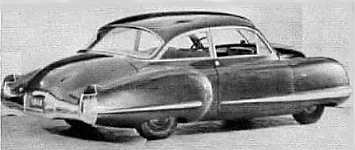
GM [Cadillac] (USA) This designer's
drawing shows the license tag "GM194X". It appears to be a proposal for
an early post-WW2 Cadillac.
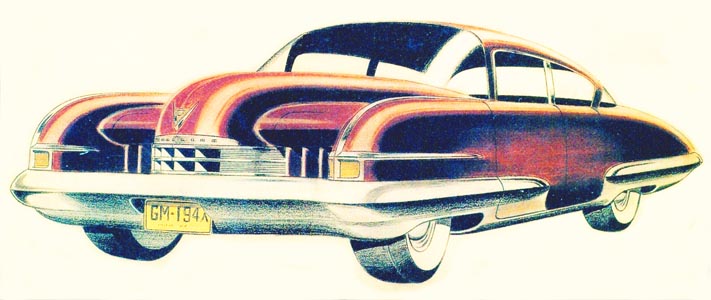
GM [Cadillac] (USA) This clay buck was
completed in
1946; a prototype car closely resembling this design was actually built and tested (see
1946, below). Note how the broad rectangular grille openings, front fender
sweep and "A" pillar resemble closely those in the colored sketch, above.
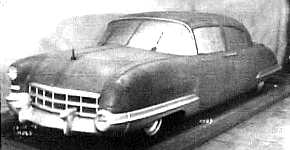
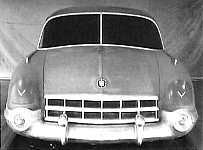

1946
Coachcraft (USA) "The Queen"; customized sedan
built on the commercial chassis; no details available other than ¾ RH front view in SSA
1993, p.6
Derham (USA) Fleetwood 60S town car, McC p.265. This Derham conversion of a
regular Series 60 Special sedan was commissioned by the Duke of
Windsor. It featrured a Haartz pdded top and a smaller, oval rear window.
Interior appointments were particularly luxurious; behind the divison (unusual
set-up in a 60S, were a bar, smoking set, vanity case for
the Duchess and a car radio.
The following text is copied from
an Internet website
devoted entrirely to Derham coachwork: Derham
produced a fair number of “converted” town cars built using existing
long-wheelbase 7- or 8-passenger limousines. They would remove the stock windshield and
the front portion of the roof back to the B-pillar. Parts of the front door above the
belt-line were cut away, and installed extra-tall (by 3”) chrome-framed
convertible-style windows in their place. A slightly higher (by three-and-a-half inches)
windshield frame was made from cast bronze and a new piece of safety glass installed in
it. Derham typically painted the wood-grained dash to match the body color and would
sometimes damascene the instrument panel and glovebox door for a more custom look. A
division window and storage compartment would be built and inserted directly behind the
driver’s bench seat. A lightweight removable canopy was then fitted over the
driver’s compartment that could be stored behind it when not in use. The factory
upholstery would remain, with only a minimum of work required to cover the lower portion
of the divider with matching upholstery. Typically the rear quarter windows were removed
and covered with sheet steel over which Derham’s trademark padded-leather top would
be installed to finish off the job. A true custom town car was ready for the customer in
as little as a week compared to the 2-3 months typically required for a true composite
custom body. The body work involved was minimal and its low cost enabled Derham to sell
their custom conversions for a fraction of the $15,000 needed to build a true coachbuilt
custom. Popular options included a completely new interior, an electric division window
and custom paint schemes. For budget-minded customers, the same look could be accomplished
using a totally enclosed 7- or 8-passenger limousine that didn’t require the
expensive bodywork and new windshield. The padded top could be extended forward to the top
of the windscreen, or could be built from the B-pillar giving the impression of a town car
but at a much-reduced cost. While Derham was not the first coachbuilder to put a
padded-leather top on a vehicle, they were clearly responsible for making it a popular
accessory and it ultimately became known in the industry as a “Derham Top”. Enos
Derham recalled, "One day a man from the (Cadillac) factory asked how many of these
we were selling a year. Like a jackass I wrote and told him. The next year they brought it
out at the (Cadillac) factory."
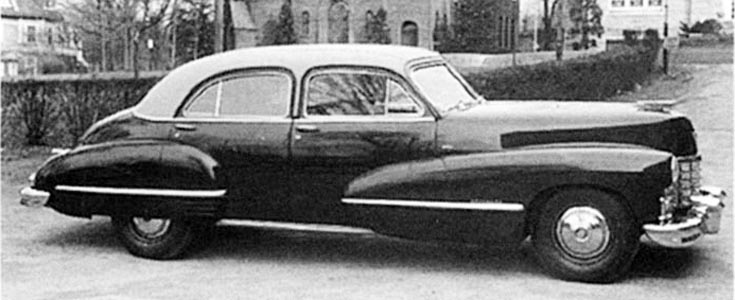
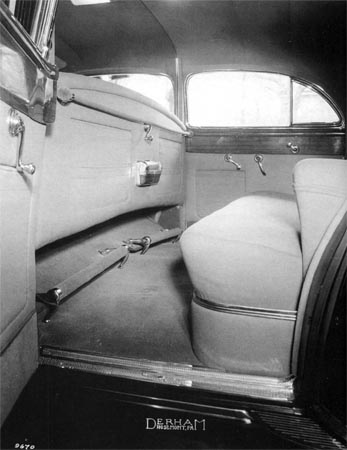
Fleetwood (USA) Series 75 on 136" wheel base converted for
railroad track inspection (SS 4/92, pp.7-8); initially called "track
cars" or "speeders", these vehicles were fitted with spoked flanged wheels,
sandboxes under the front fenders, a turntable suspended under the car (enabling it to be
jacked up and swung around 180°), pilot, roof-top horns and luggage rack, and red light.
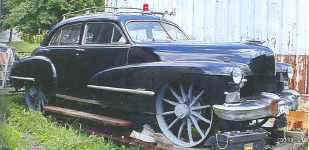
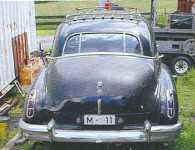
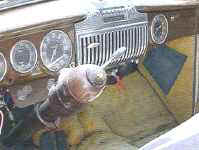
[ Photos: courtesy CLC, Self Starter ]
GM Styling (USA) Concept car project for a post-WW2 sedan
(possible new "Sixty Special"). I for one am happy that this design did
not make it into production!
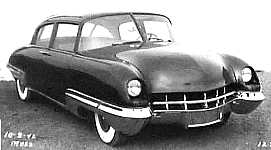
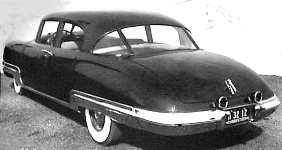
GM Styling (USA) The artist's drawings below
are by Cadillac designer, Raoul Pepin; they were supplied kindly by fellow Cadillac
enthusiast Eric George who writes: that 1946 concept car [drawing below] isn't
such a dud after all. It's general lay-out is very much as Cadillacs would be by the
mid-fifties. I mean by this the proportions, short hood, long deck. The first concepts for
the Eldorado Brougham from the early 50's have this lay-out in an exaggerated form. There
is of course the aircraft inspired wraparound windshield that probably makes it's first
appearance in this car. The roof form aft of the "A" pillar including the
wraparound rear window is the same as on the 1950 series 61 sedan. As I said before, the
long rounded rear deck and chrome bumper-fender skirts are strongly reminiscent of the
1957-58 Eldorado. Eric mentioned also that he had seen somewhere another black and
white drawing, reminiscent of this 1946 concept car, from the early 1940's; it had a full
Plexiglas roof and a generally more exaggerated, cartoonish, Buck Rodgers rocket ship
style. It too may have been a Pepin design
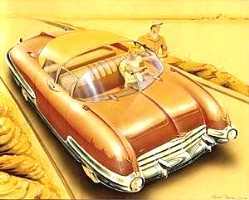
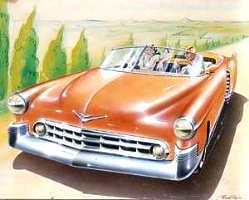
Early post-war Cadillac designs by in-house artist,
Raoul Pepin
Left: 1946 proposal; right: a similar proposal for 1947
GM Styling (USA) Full-sized clay model of proposed Series
60 Special model for 1949 (photo dated 02.19.46)

[ Information and photo: courtesy CLC and Steve
Wolken ]
GM Styling (USA) Another, later, full-sized clay model of
proposed Series 60 Special model for 1949 (photo dated 08.13.46)

[ Information and photo: courtesy CLC and Steve
Wolken ]
Schwartz, Maurice (USA)
custom Woody wagon on Cadillac "75" Series chassis for MGM
studios in Hollywood. Between 1947
and 1949, MGM Studios ordered six Series 75 Cadillac chassis from
Hillcrest Cadillac, the Beverly Hills dealer. These chassis were
dispatched to Maurice Schwartz ro receive custom, “woody” bodies. This
6-door jitney, built on a 1946 Series 75 chassis,
was ordered by a major Hollywood movie studio; it was used to ferry
actors to and from shooting locations. Note that it features the tail-light
assemblies of 1940 Cadillac models.
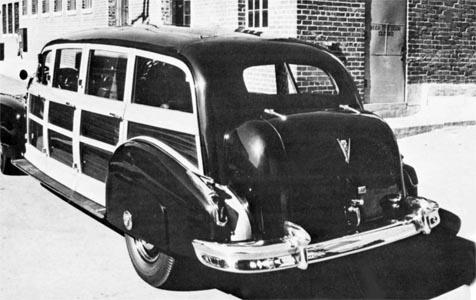
[Unknown, USA] Based on a 1946 model, this radical custom
is distinguished, above all, by its 1941 Cadillac grille. The car was offered for sale on
e-Bay in November, 2003
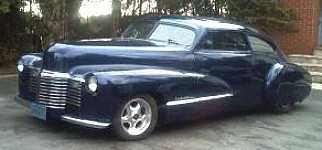
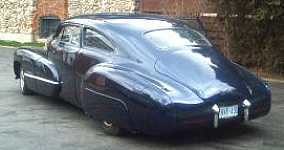
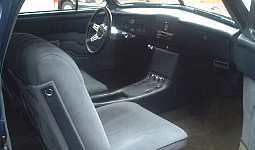
[Unknown, USA] Based on a 1946 Series 60 Special
sedan, this station wagon conversion was sold at a Kruse auction in Auburn, IN, in the
Fall of 2006 for $51,000
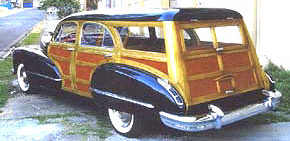
[Unknown, USA - possibly Maurice Schwartz] Here's another woody on Cadillac chassis
(probably a modified "Series 75" sedan or limousine.
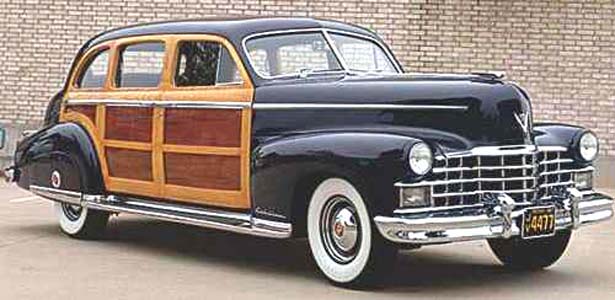
[Unknown, USA] Based on a 1946 "Series 75" this formal looking people hauler with false landau bars on the quarter panels
was available for sale in 2008.
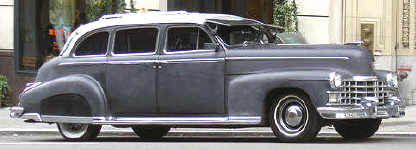
[Unknown, USA] and unusual too, is this railroad
inspection car, converted from a Series 62 sedan; it was used by the Western
Maryland Railroad corp. Pics are from a story written by CLC Museum curator, Tim Pawl, for
the Self-Starter issue of July, 2008.



Note absence of (pointless) steering wheel
[ Photos: © Self Starter ]
1946-47
[Unknown, USA] an unusual 2-pass. roadster on Cadillac
chassis and drivetrain.
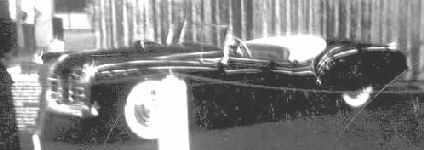
1947
Barris (USA) Featured in Motor Trend, August 1958, p.39, this
customized car was described thus: "Advance design work is indicated in this '47
Cadillac with its de ville-type leather-covered top, removable wrap-around rear window
glass, and the 'floating' separated front bumpers. Body sculpturing is evident in the
front fender crease which fades into the frenched headlight, and the slightly peaked hood,
shaved of its usual ornamentation. Floating-type grille is set into a reshaped horizontal
chrome shell."
Bohman & Schwartz (USA) An unusual camper on commercial
chassis. This vehicle came up for sale on Ebay in 2010. It appeared in poor
condition; not surprising after 62 years!
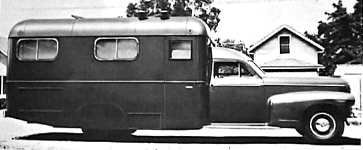
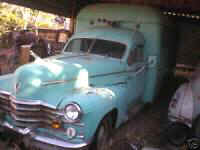
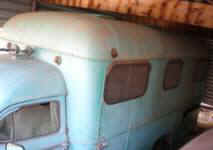
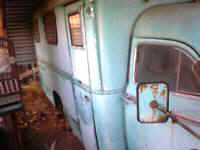
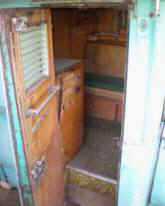
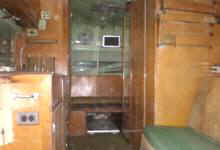
Here is the same car, 62 years later !
[ Photos: Ebay web site ]
Coachcraft (USA) a 1941 model converted to a 2-door 1947 roadster
by adding a 1947 grille, after the car had been damaged in a fire. Called the
"William Holden" car, Rudy Stoessl, the man behind Coachcraft did not recall the
screen star ever having been involved with it. No "V" and crest was featured nor
was the 1947 Cadillac script. Photo of ¾ RH front view in SSA 1993,
p.6, taken in 1949.
Derham (???) (USA) I copied from the ZTV
collection, in May 1994, a B&W shot of a special 1947 limousine with cloth top, posing
beside a fire hydrant (photo, below). I wonder if this is the same car shown in McC
p.272 and Sch40, p.119. Haartz cloth coverings were used
on some formal jobs, like this one, but the customary top color was
black.
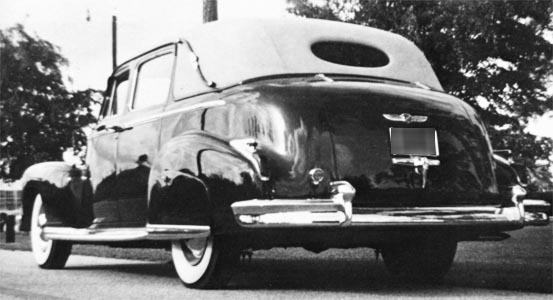
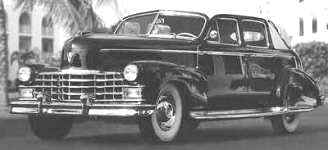
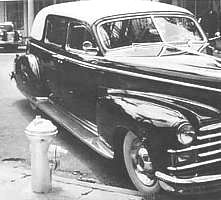
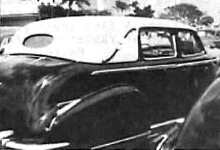
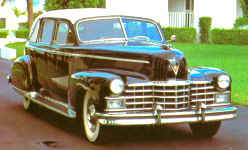
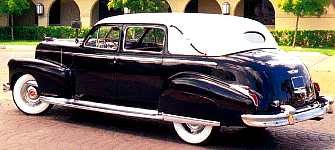
I'm assuming all these photos are of the same car,
taken at different venues in the last 20 years
Derham (USA) 4-door convertible sedan on Series 75 chassis;
photo: Sch40, p.118; commissioned by
King Farouk of Egypt.
Derham (USA) town car conversion from Series 75 limousine, Sch40,
p.119. Informal limousines (those with painted metal roofs) were uncommon.
More popular were leather covered roofs and enclosed rear quarters.
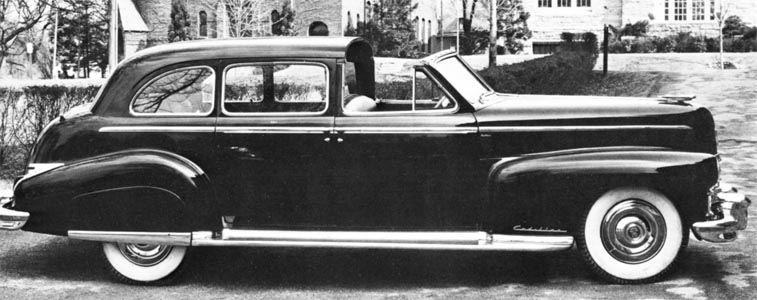
Derham (USA) 4-door state limousine specially outfitted for H.H.
the Pope Pius XI.
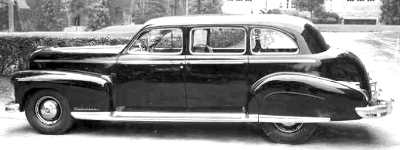
Derham (USA) 4-door formal
limousine with typical Derham.style oval backlight. Roy Schneider, who
wrote the definitive book, "Cadillacs of the Forties", was able to view
the Derham archives; these indicated that 12 formal limousine
conversions like this one were completed in 1947.
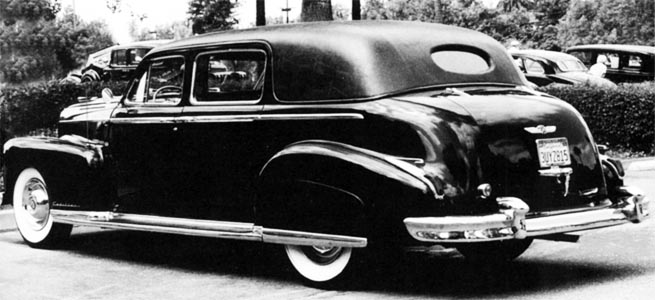
Derham (USA) formal sedan conversion on Series 75
limousine, with padded leather roof
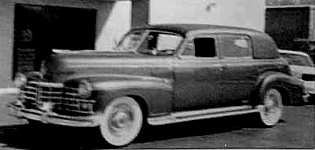
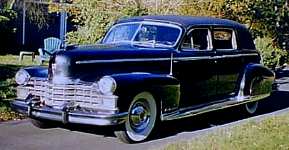
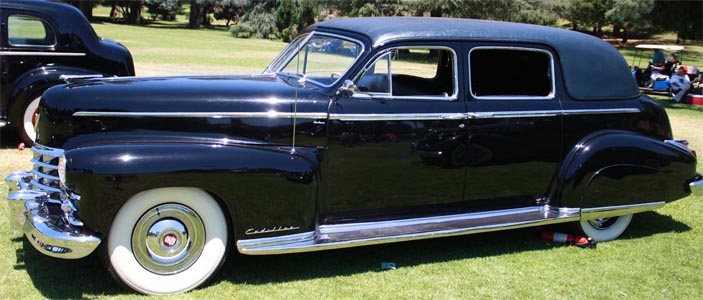
Not sure if these three photos depict the same car or
not
Derham (???) (USA) a 4-door formal sedan with small
circular quarter windows and fancy carriage lamps.
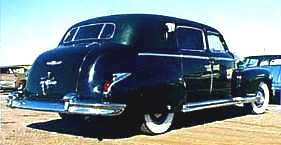
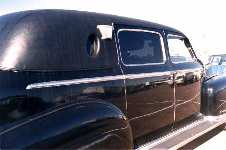
Derham (USA) This
mildly modified limousine may have
been made for the funeral trade. It has, in addition to faux landau bars [an
unusual feature on a Derham conversion], the typical front hood chrome markings of the
Sayers & Scovill (S&S) funeral coaches.
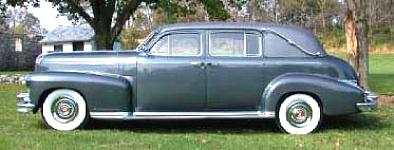
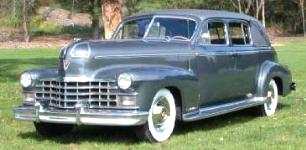
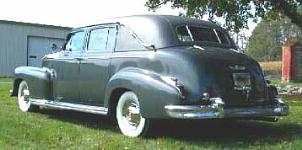
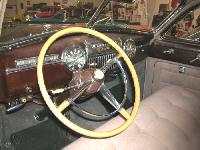
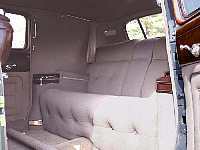
[ Photos: Internet, 11/2004 ]
De Rosa, Frank (USA) the Hollywood customizer created this
chopped-chaneled-sectioned 1947 Cadillac Kustom.
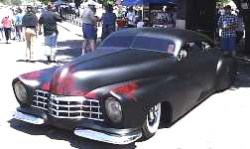
Photo: courtesy Tony Wood
Fisher/Fleetwood (???) (USA) modified Buick "Y-Job"
(special order # 13690), Alfred P. Sloan Museum, Flint, MI. Not a Cadillac, but deserving
of recording here as having inspired many future Cadillac dream cars and given typical
Cadillac features to later production automobiles.
Mattar (USA) This oddity was created by Louis Mattar
of San Diego, CA, for his retirement. Sorry, I couldn't resist including it. Its
convenience items include hot and cold shower, electric kettle, vanity case, stove,
refrigerator, washing machine, ironing board, color TV, stereo system, telephone and the
all-important wet-bar. The rear seat converts to a bed for two. Louis wants to add a
computer and a miniature putting green! Article in PS 5/52, pp.130-131. For more
information about this curious Cadillac, check out this French-language Web page
on the Internet [thanks to Brian Grittner in MN for the tip].
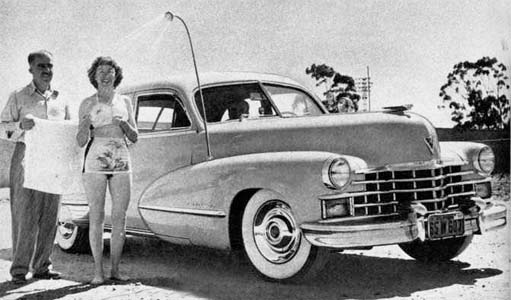
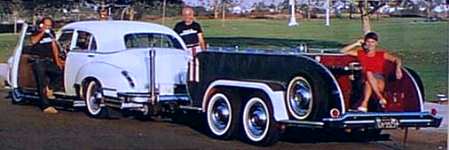
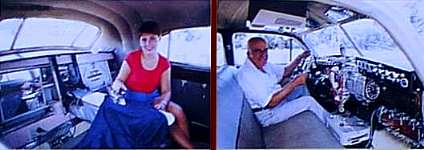
Reinbolt & Christé (Switzerland) custom 4-door convertible
sedan with reversed front "suicide" doors; the front clip is all Cadillac but
major modifications appear to have been done to the rear. I believe this car has
survived. It is not known what chassis was used to accommodate the large convertible
body.

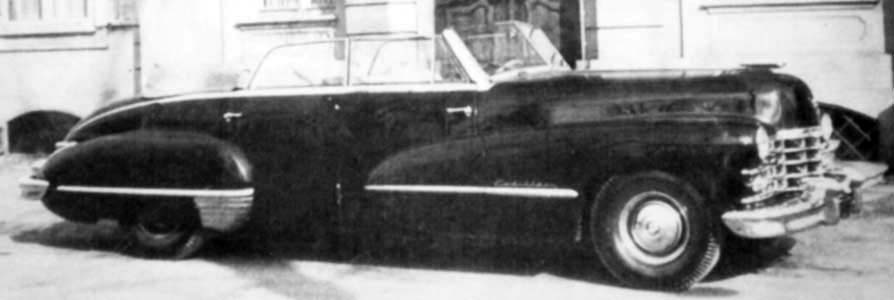
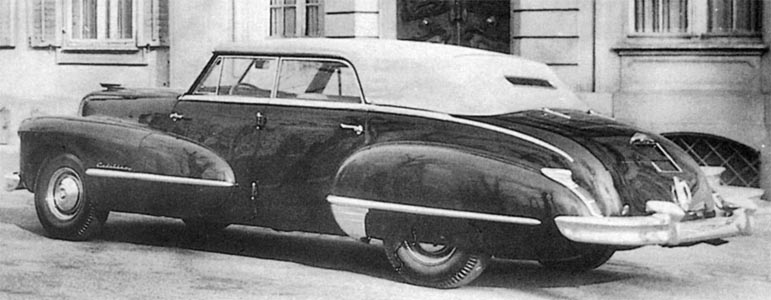
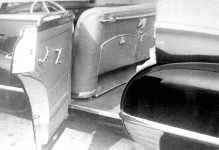
[ Photos:
© 1992, Autovision ]
Schwartz, Maurice (USA)
custom Woody wagon on Cadillac "75" Series chassis for MGM
studios in Hollywood. Between 1947
and 1949, MGM Studios ordered six Series 75 Cadillac chassis from
Hillcrest Cadillac, the Beverly Hills dealer. These chassis were
dispatched to Maurice Schwartz ro receive custom, “woody” bodies. This
6-door station wagon, (2nd unit), was built for
cowboy star-singer Gene Autry, Sch40, p.120, McC p.272
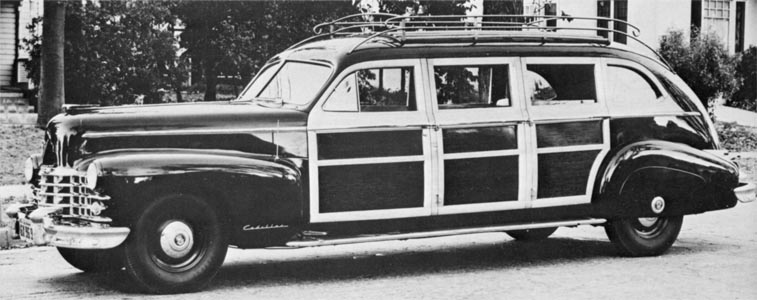
Schwartz, Maurice (USA) conversion on Series 75 chassis
commissioned by shoe magnate, Harry Karl, for his singer-actress wife, Marie McDonald.
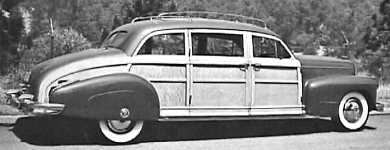
Unknown (UK) At a Kruse auction in Auburn, IN, in Sept. 1999, a
fastback Series 61 Sedanet with a custom body was offered for sale (lot #4456); it
reportedly found a buyer at $#4,000. The catalog mentioned that the car was
previously owned by Lieutenant General Walter Rhodes, USAF, who was stationed in England
from 1941 to 1967. The car was shipped to England as a bare chassis and a body was fitted
there by an unknown UK coach builder; the car was stretched seven inches.
Unknown (probably USA) Possibly a conversion by Derham on the
chassis of the Series 75. The photo below was taken at a meet in the
seventies.
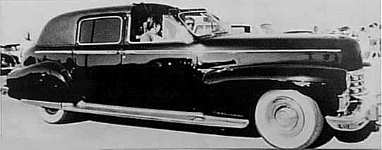
Unknown (USA) but probably Fisher or
Fleetwood; Series 60 Special sedan. The phot was taken at the
Cadillac Grand National meet in Las Vegas by me friend and fellow 1942
Cadillac owner, Jeff Hansen
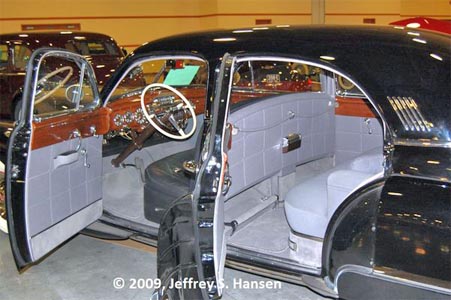
Unknown (probably USA) This pick-up truck, believed
to be from the Le May collection in Seattle, WA, has THREE Goddess ornaments: one on
the hood and one on at the front of each fender.